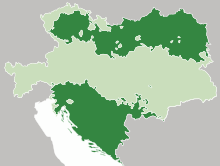Army Slavic
This article includes a list of references, related reading or external links, but its sources remain unclear because it lacks inline citations. (February 2013) |
| Army Slavic | |
|---|---|
| Armee-Slawisch | |
| Created by | Austro-Hungarian Army |
| Setting and usage | Military communication |
| Era | after 1867 – 1918 |
| Purpose | select vocabulary |
| Language codes | |
| ISO 639-3 | – |
 The extent of Slavic people in Austria-Hungary (1910)
Slavs
Other ethnicities | |
Army Slavic (German: Armee-Slawisch) was a rump vocabulary consisting of about eighty key words, mostly of Czech origin. It was developed to help with language barriers in Austria-Hungary, and was in use until the end of the World War I.
Part of the reason for the existence of this specialized vocabulary was the fact that while German and Hungarian were official languages, half of the soldiery was recruited from areas that spoke various Slavic languages. In all, there were eleven different official languages to contend with. While efforts were made to keep soldiers grouped by language, mixed language units still occurred.
References[]
- Deak, Istvan (1989), Beyond Nationalism: A Social and Political History of the Habsburg Officer Corps, 1848-1918, Oxford University Press, p. 100
- Walter, John (1999), Central Powers' Small Arms of World War One, Crowood Press, ISBN 1-86126-124-1
Categories:
- Military of Austria-Hungary
- Simplified languages
- Slavic language stubs
- Pidgin and creole language stubs
- World War I stubs